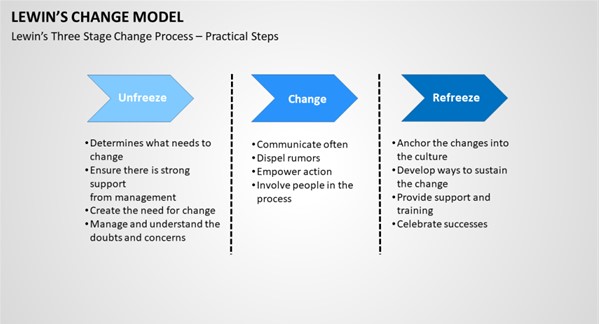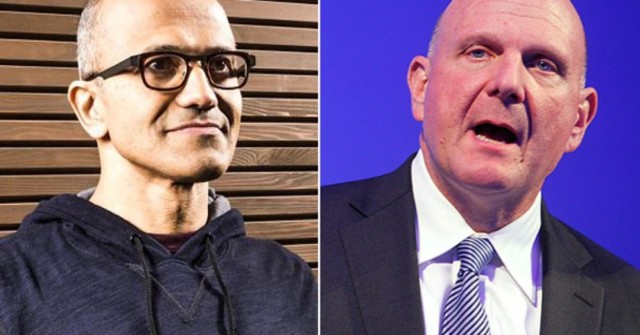Change in an organization refers to the process of revamping the direction, structure and capabilities to match the changing demands of the companies external and internal customers (By 2005). Ebongkeng (2018) added that change leads the managerial staff to be proactive towards environmental change or challenges. Organization change allows companies to remain competitive and statistical data showed that one third of organization change by leaders were perceived successful (Pieterse, Caniels and Homan 2012). According to Husain (2013), communication between staff and leaders are required as they cannot assume that everyone will accept change and communication towards change must be initiated systematically.
Resistance towards Change
Resistance is deemed to happen in an organization when less employee participation is involved in the decision making process and lack of trust in the contribution of the management (Boohene and Williams 2012). The two sources on resisting organizational change are individual sources and organizational source (Masunda 2015). The author mentioned that individual sources were due to accustomed ways and the need for security is high as it threatens their feelings and safety. Besides this, resistance by organizational sources were due to limited focus of change which were rejected by large groups (Masunda 2015).
Statement by Mullins (2013)
I would disagree towards the sentence by Mullins ‘there is little management can do about resistance to change’. There are ways for management to handle resistance towards change and the key factor is communication within the organization.
Lewin Model Theory
This Lewin model was founded by Kurt Lewin in 1947 which was considered the pioneer in change management comprising of three steps of change which is unfreeze, change, refreeze (Cummings, Bridgeman and Brown 2016). The first step which is unfreezing refers to the process of discarding old methods and ready to adapt new behaviors (Sarayreh, Khudair and Barakat 2013). Step two refers to the change in processes whereas step three is refreezing which states the stability of the group after a new behavior has been adopted. Lock (2018) stated that if any of these steps were missed; the process of change will encounter resistance as the old values will resurface to counter the change.

Figure 1-Kurt Lewin’s Change Model
Limitation of the model
According to Cummings, Bridgeman and Brown (2016), the inelastic idea of the stage ‘refreeze’ is not appropriate in our current competitive world which will require flexibility and adaption. Moreover, this model is too simple in today’s organization as it does not cater to rapid change (Lock 2018).
Kotter’s 8-Step Process
Apart from Lewin’s theory, managers can add on by using Kotter’s 8 step model to implement change powerfully and successfully in an organization. According to Kotter (2006), there are 8 steps which companies can adapt but a sense of urgency has to be developed prior to proceeding with the remaining steps.

Figure 2- Kotter’s 8 Step Process
Examples of successful change (Microsoft)

Figure 3-Current CEO Satya Nadella and Ex-CEO Steve Ballmer
Microsoft had restructured their organizational chart which was then steered by the Ex-CEO Steve Ballmer towards the end of his career in order to curb the downturn of customers and keep up with competitors like Apple and Google (Molina and Acohido 2013). The authors added that upon the reshuffling, its share rose by 2.8%. New CEO Satya Nadella restructured the organization in 2018 to bring in more Artificial Intelligence (AI) into the Microsoft range. Microsoft took a new direction in splitting into three major divisions which are Experiences and Devices, Cloud and AI platform and existing Microsoft research branch (Gershgorn 2018). The resulting change boosted the company’s stock market to USD 712 Billion which was a whopping 143% in 2014 and maintained an annual growth of revenue which significantly grew due to its leadership style (Cohan 2018). Although there were layoffs in the process, it was largely in the sales division which contributes to less than 10% of the company’s total sales force from a total of 200,000 employees globally (Haselton 2017). The author added that this change is not about cost cutting but a reflection of Microsoft’s sales handling in order to grow.
Conclusion
Leaders in organizations should be considerate towards the acceptance or the resistance of change which is introduced to overcome challenges faced by the company. By applying the right theory and framework, leaders can manage the organization, guide and communicate in order for a successful change. As quoted by Mark Zuckerberg, “In a world that’s changing really quickly, the only strategy that is guaranteed to fail is not taking risk” (Phillips 2014).
(752 Words).
Reference
By, R.T. (2005) ‘Organisational change management: A Critical Review’. Journal of change management. 5 (4). [Online]. Available from < https://www.researchgate.net/publication/233604011_Organizational_Change_Management_A_Critical_Review> [14 March 2019].
Boohene, R., Williams, A.A. (2012) ‘Resistance to organizational change: A case study of oti yeboah complex limited’. 2 (4). [Online]. Available from <www.cscanada.net/index.php/ibm/article/download/j.ibm.1923842820120401…/pdf> [14 March 2019].
Cohan, P. (2018) ‘Successful Leadership Turbocharged Microsoft’s Value by $ 430 Billion’. Inc [online] 11th April. Available from <https://www.inc.com/kevin-j-ryan/adidas-future-lab-video.html> [13th March 2019].
Craig, W. (2017) ‘Successful Tips for leading your team through change’. Forbes [online] 12th December. Available from <https://www.forbes.com/sites/williamcraig/2017/12/12/successful-tips-for-leading-your-team-through-change/#2b7b1d1a1c4b> [13th March 2019].
Cummings, S., Bridgeman, T., Brown, K.G. (2016) ‘Unfreezing change as three steps: Rethinking Kurt Lewin’s legacy for change management’. 69 (1) 33-60. [Online]. Available from <https://journals.sagepub.com/doi/pdf/10.1177/0018726715577707> [14 March 2019].
Ebongkeng, H (2018) Organizational change and performance [online] available from <https://www.theseus.fi/bitstream/handle/10024/142378/Helen%20Ebongkeng.pdf?sequence=1&isAllowed=y> [13 March 2019].
Fortt, J. (2017) ‘Microsoft plans thousands of job cuts in a sales staff overhaul to fuel cloud growth’. Cnbc [online] 6th July. Available from <https://www.cnbc.com/2017/07/06/microsoft-will-layoff-thousands-of-employees.html> [13th March 2019].
Gershgorn, D. (2018) ‘Microsoft reshuffles to bring more AI into products’. Quartz [online] 29th March. Available from <https://qz.com/1240855/microsoft-ceo-satya-nadella-is-reorganizing-the-company-to-bring-more-ai-into-products/> [13th March 2019].
Husain, Z. (2013) ‘Effective communication brings successful organizational change ’. 3 (2) [Online]. Available from <http://www.abrmr.com/myfile/conference_proceedings/Con_Pro_12315/7-dubai13.pdf> [14 March 2019].
Kotter, J.P. (2006) Leading Change why transformational effort fail [online] available from <https://wdhb.org.nz/contented/clientfiles/whanganui-district-health-board/files/rttc_leading-change-by-j-kotter-harvard-business-review.pdf> [13 March 2019].
Lock, D (2018) Charting For Change in the workplace [online] available from <https://www.humansynergistics.com/blog/culture-university/details/culture-university/2018/01/31/charting-for-change-in-the-workplace> [13 March 2019].
Mullins, L. J. (2010) Management & Organizational behavior [online] 9th Edition available from <http://www.mim.ac.mw/books/Management%20&%20Organisational%20Behaviour,%209th%20edition.pdf> [18th January 2019].
Molina, B. and Acohido, B. (2013) ‘Microsoft reshuffles company structure’. USA Today [online] 11th July. Available from <https://www.usatoday.com/story/tech/2013/07/11/microsoft-restructuring/2508175/> [13th March 2019].
Masunda, T (2015) An Evaluation of resistance to organizational change and its effect on employee productivity [online] available from <http://citeseerx.ist.psu.edu/viewdoc/download?doi=10.1.1.877.2775&rep=rep1&type=pdf> [13 March 2019].
Pieterse, J. H., Caniels, M. CJ. , Homan, T. (2012) ‘Professional discourses and resistance to change. 25 (6). [Online]. Available from <https://www.ou.nl/Docs/Faculteiten/MW/artikelen%20Thijs%20Homan/PIETERSE%20CANIELS%20AND%20HOMAN%202012%20-%20JOCM%2025(6).pdf> [14 March 2019].
Sarayreh, B.H., Khudair, H., Barakat, E.A. (2013) ‘Comparative study: The Kurt Lewin of change management’. 2 (4). [Online]. Available from <https://www.ijcit.com/archives/volume2/issue4/Paper020413.pdf> [14 March 2019].
Hi Pranshan, well done on your research, base on your opinion do you think which model is useful for a leader to apply on changes management?
LikeLike
Hi alex, In my opinion there is no best model for a leader to use. Therefore it is wise for the leader to know the skills they have and know various types of change model out there so that leaders can apply based on which is suitable for them.
LikeLike
Hi Prashanth, good explanation with real life example. Changes process is complicated and it can bring conflict between employer and employee. As a manager, we have to agree on company perspective, but as a leader, we need to consider employee’s concern. How would you solve the conflict ?
LikeLike
Hi Amy Thanks. As a leader i would take all consideration and understand why do they conflict occur and assist the employee in the best way possible to go through change.
LikeLike
Hi Prashanth, interesting blog. In your opinion, what would happen to an organisation that resist changes?
LikeLike
Hi Sara, Thanks. In my opinion resistance of change brings negative effect such as low morale, less efficient and disruption at work.
LikeLike
Good sharing Prashanth. In your opinion, how does effective communication overcome the resistance of change?
LikeLike
Thanks Fong. Effective Communication aids in making employees understand main focus why change is needed in the organisation. Once they have understood the drive of the company and benefits resistance will would fade.
LikeLike
Do you think organizational change is necessary and beneficial all types of industry ?
LikeLike
Hi Jeremy, Yes it is necessary and beneficial for change to happen in all types of industry in order to replace the old habits and go on with the new.
LikeLike
Hi Prashant,
Well written! In your opinion, which is your preferred model of change, Lewin’s Model or Kotter’s 8 step process?
LikeLike
Hi Piaree, Personally i would like to apply Lewins change model but if i face any challenges or limitations, i would consider a second model which can help me overcome the shortage which i face.
LikeLiked by 1 person